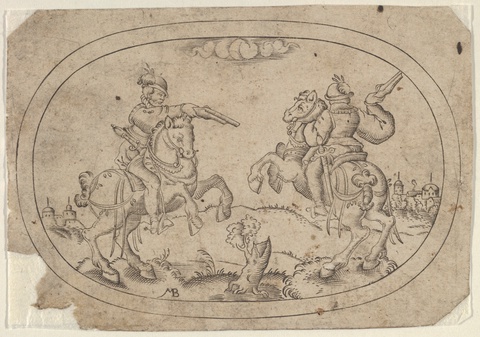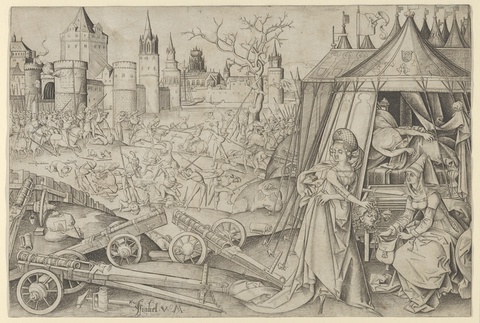Firearms Enter the Picture: Guns and Their Representation Before 1600
By Reina Gattuso•June 2022•6 Minute Read
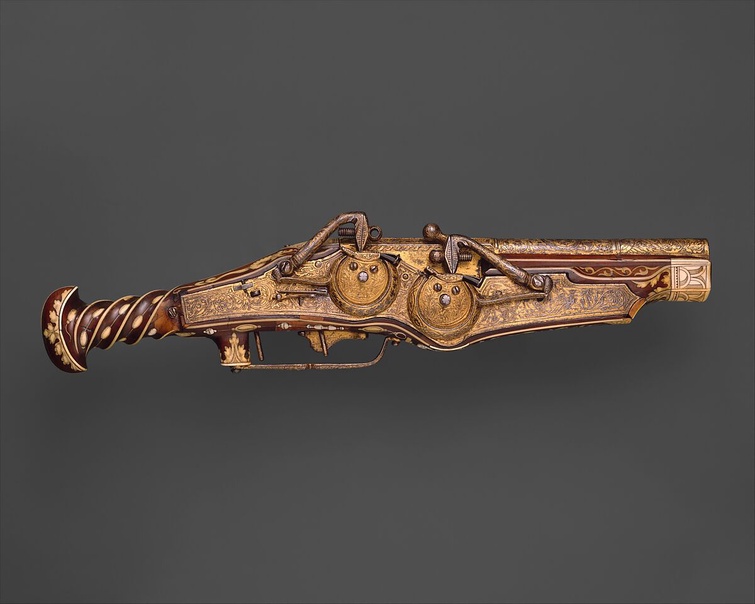
Peter Peck, Double-Barreled Wheellock Pistol Made for Emperor Charles V, ca. 1540–45. Metropolitan Museum of Art. This ornamental gun is intricately designed for divine royalty.
Chinese fighters were the first to use firearms in battle, starting in the 1100s. The technology spread across Europe and Asia over the next few centuries. Guns permanently changed the nature of warfare—and the way humans imagine violence. These images reveal medieval peoples’ responses to this lethal innovation.
Chinese scientists first developed gunpowder as a mystical substance. They were searching for an alchemical compound that would give them immortal life. Military strategists began using gunpowder in war to light fires on the battlefield, a common tactic to confuse the enemy.1 Guns were engineered for soldiers to launch the gunpowder across land. Evidence of the first handheld bronze guns dates back to China in the early 1300s.
Soon after, firearms, including cannons, entered battlefields and imaginations across Eurasia. Because bullets could pierce steel, firearms fundamentally changed armor designs, eventually making the “knight in shining armor” obsolete.2 Artists included firearms in their depictions of battles. They also incorporated firearms into how they imagined human violence, sometimes including firearms in depictions of ancient myths as well as contemporary conflict.
This piece examines several early firearms, as well as early drawings of guns. The dissemination of the gun followed the path of Mongol conquest from east to west in the 13th and 14th centuries. Later on, guns became key enablers of European and Euro-American colonial brutality. Along the way, firearms fundamentally changed the human imagination of violence.
Making Early Firearms
Archeological evidence suggests that the first firearms used in battle were Chinese fire lances. They were effectively gunpowder-filled flamethrowers made of bamboo.3
Chinese scientists subsequently developed hand cannons like the 1424 Chinese bronze version pictured here. To use early guns like this, fighters filled the metal tubes with gunpowder and a projectile, manually lighting the charge through a hole.4
Guns spread along the Silk Road and through Mongol invasions. Middle Eastern soldiers were using handheld guns, as opposed to cannons, by the late 1300s.5 Gun making grew more sophisticated alongside other technologies, like the watch, which was first developed in the 16th century.
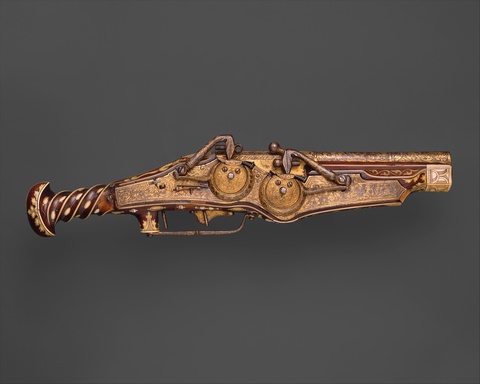
German Peter Peck, who created this pistol for Holy Roman Emperor Charles V, made both watches and guns. “Wheellock”-style guns used similar mechanisms as watches of the era, such as gears. This enabled users to pull a trigger rather than manually igniting the gun. Smaller, handheld weapons changed battle tactics and came to be status symbols.
Artists illustrated the technical process of making guns. By the late 1500s, cannons and guns were common on the European battlefield.
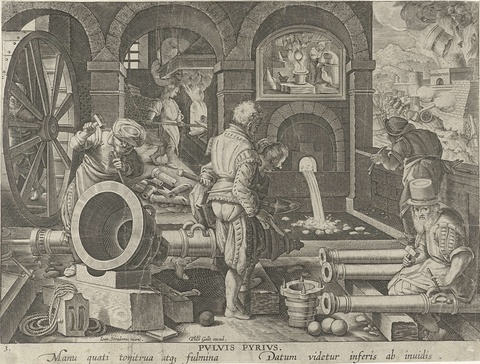
This print, from a series illustrating the origins of various inventions, depicts a Dutch artillery maker with a siege in the background. The illustration demonstrates contemporary Europeans’ interest in innovations in warfare and other technology. It portrays Berthold der Schwarz, a 14th-century monk and alchemist, presiding over the scene. European scholars from the 1400–1800s claimed Schwarz was the inventor of gunpowder, based on a few, possibly apocryphal town records in Ghent, Belgium.6 Modern scholars are unclear on whether Schwarz actually existed. By his supposed lifetime, gunpowder had already been in use for about 200 years since it originated in China.7
Guns Enter the Battlefield
Artistic depictions of guns entered Asian and European artworks soon after the invention of guns themselves. Art from the 1500s in Asia and Europe shows how guns changed contemporary war.
South Asians first encountered gunpowder in the 1200s and started using firearms in the 1300s. The Mughals used firearms to expand their power in the 1500s.8 This page from the Akbarnama (“Book of Emperor Akbar”), dating to the 1590s, shows firearms’ importance to the Mughals.

The miniature painting illustrates an incident early in Akbar’s reign when the young Emperor had a previous court favorite arrested for insolence. In the foreground, two courtiers bear rifles. The guns must have been a strong warning to any other members of court thinking of disobeying the teenaged king.
Meanwhile, in Europe, handheld guns were accessible enough by the 1500s to have changed battle tactics. Earlier designs for plates such as this engraving may have depicted two knights dueling with lances. In this design from 1582, however, the riders duel with guns.
The riders’ relative lack of plate armor mirrored the broader trend towards guns and cannons. Plate armor was useful protection against the blades that dominated medieval European warfare, but is less effective against bullets.9 By the 1600s, ever-more-powerful guns were quickly making heavy plate armor obsolete.10
Once guns reached Europe, they became inextricable from the history of European colonialism. This 1598 drawing is a preliminary sketch for a later painting by Flemish artist Stradanus. It shows Spanish soldiers with guns fighting Filipino troops armed with bows and arrows. The work represents a European imagination of the battle, rather than something we can trust as documentary evidence.
People in the Philippines used firearms in warfare prior to Spanish invasion. The Spanish used firearms as part of their colonial military campaigns in North and South America and parts of Asia and Africa.
Firearms Remake Myth
Artists have long depicted mythical stories using contemporary dress and conventions. As guns became increasingly common in Europe and Asia, artists began including them anachronistically in depictions of historical conflicts.
This engraving tells the biblical tale of Judith, a Jewish heroine who saved her people from the Assyrian general Holofernes by seducing and then decapitating him. Over centuries, artists, particularly in Europe, have portrayed the scene as an example of women’s power and rage.11
Because this is a German illustration of the tale from the late 1400s, the artist depicts Judith as a European woman in Renaissance clothing. She hands her female companion Holofernes’ head as a battle rages in the background. In the foreground, the Old Testament heroine stands next to some anachronistic military technology: cannons.
By embellishing this ancient tale with a modern innovation in warfare, the artist signified a broader shift in human technologies of violence. As firearm technology advanced, guns increasingly enabled users to hurt and kill one another with less effort. Never before had human beings been able to kill one another with the touch of a trigger.
Reina Gattuso is a content writer on the Curationist team, and an independent journalist covering gender and sexuality, arts and culture, and food. Her journalism connects analysis of structural inequality to everyday stories of community, creativity, and care. Her work has appeared at Atlas Obscura, The Washington Post, Teen Vogue, The Lily, POPSUGAR, and more. Reina has an MA in Arts and Aesthetics (cinema, performance, and visual studies) from Jawaharlal Nehru University in New Delhi, India, where her research focused on sexuality in Hindi film. She writes and teaches writing to high school students in New York City.
Citations
Patricia Buckley Ebrey, ed. “Gunpowder and Firearms.” A Visual Sourcebook of Chinese Civilization, https://depts.washington.edu/chinaciv/miltech/firearms.htm. Accessed 25 March 2022.
Breiding, Dirk H. “Arms and Armor—Common Misconceptions.” The Metropolitan Museum of Art, October 2004, https://www.metmuseum.org/toah/hd/aams/hd_aams.htm. Accessed 25 March 2022.
Powell, Eric A. “Fire Lances and Cannons.” Archaeology, May/June 2020, https://www.archaeology.org/issues/378-2005/features/8599-fire-lances-cannons. Accessed 25 March 2022.
“Gun Timeline.” History Detectives, PBS, https://www.pbs.org/opb/historydetectives/technique/gun-timeline/. Accessed 25 March 2022.
“History of the firearm.” Wikipedia, 15 March 2022, https://en.wikipedia.org/wiki/History_of_the_firearm. Accessed 25 March 2022.
Amy Tikkanen, ed. “Berthold der Schwarze.” Britannica, 13 May 2020, https://www.britannica.com/biography/Berthold-der-Schwarze. Accessed 25 March 2022.
“Berthold Schwarz.” Wikipedia, 31 October 2021, https://en.wikipedia.org/wiki/Berthold_Schwarz. Accessed 25 March 2022.
“Timeline of the gunpowder age.” Wikipedia, 1 March 2022, https://en.wikipedia.org/wiki/Timeline_of_the_gunpowder_age. Accessed 25 March 2022.
Mansoor, Peter. “Armor.” Britannica, 16 May 2019, https://www.britannica.com/topic/armour-protective-clothing. Accessed 25 March 2022.
Breiding. “Fashion in European Armor, 1600-1700.” The Metropolitan Museum of Art, October 2004, https://www.metmuseum.org/toah/hd/afas17/hd_afas17.htm. Accessed 25 March 2022.
Frey, Angelica. “How Judith Beheading Holofernes Became Art History’s Favorite Icon of Female Rage.” Artsy, 4 April 2019, https://www.artsy.net/article/artsy-editorial-judith-beheading-holofernes-art-historys-favorite-icon-female-rage. Accessed 25 March 2022.
Reina Gattuso is a content writer on the Curationist team, and an independent journalist covering gender and sexuality, arts and culture, and food. Her journalism connects analysis of structural inequality to everyday stories of community, creativity, and care. Her work has appeared at Atlas Obscura, The Washington Post, Teen Vogue, The Lily, POPSUGAR, and more. Reina has an MA in Arts and Aesthetics (cinema, performance, and visual studies) from Jawaharlal Nehru University in New Delhi, India, where her research focused on sexuality in Hindi film. She writes and teaches writing to high school students in New York City.

